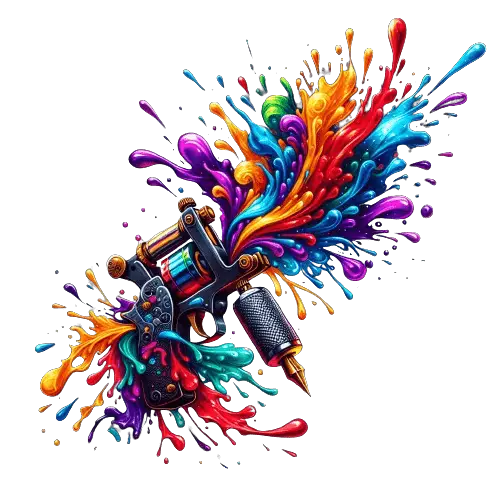Japanese snake tattoos symbolize protection, strength, transformation, and wisdom within the realm of Japanese culture and mythology. In Japanese culture, snakes are considered divine creatures with magical powers and are often associated with the deity Benzaiten, the goddess of everything that flows, including music, speech, and rivers.
Snake tattoos are commonly depicted as a coiled serpent, representing the cycle of life, death, and rebirth. The snake is believed to possess protective qualities, guarding against evil spirits and bringing good fortune to the wearer. It also represents adaptability and transformation, as snakes shed their skin, symbolizing personal growth and the ability to overcome challenges.
The intricate details and vibrant colors used in Japanese snake tattoos give them a striking appearance that captivates the eye and conveys a powerful message.

The Allure Of Japanese Snake Tattoos: Exploring The Power And Transformation Behind Mystical Symbols
The allure of japanese snake tattoos: exploring the power and transformation behind mystical symbols.
Japanese snake tattoos have captivated people around the world for their enchanting designs and profound meanings. In japanese culture, tattoos hold immense cultural significance, serving as a way to express personal identity and beliefs. With a rich history dating back centuries, snake tattoos have become an integral part of japanese tradition.
These remarkable tattoos symbolize power, transformation, and protection. Drawing inspiration from ancient folklore and mythology, japanese snake tattoos embody the duality of strength and metamorphosis. Let’s delve into the cultural significance of tattoos in japan, explore the rich history of snake tattoos, and uncover the symbolism of power and transformation that these mystical creatures represent.
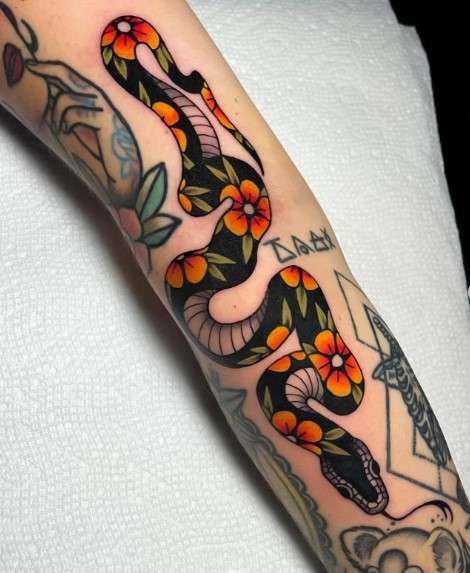
Orochimaru: The Serpent Deity Of Longevity And Rebirth
Unraveling the origin story of orochimaru:
- Orochimaru is a prominent figure in japanese folklore, often depicted as a powerful serpent deity associated with longevity and rebirth.
- According to legend, orochimaru was born as a human but possessed an insatiable desire for immortality and power.
- He delved into forbidden arts and eventually mastered the forbidden jutsu, a powerful technique that allowed him to transfer his soul into different bodies, effectively achieving immortality.
- Orochimaru’s story is closely intertwined with the world of ninjas and the mystical powers they possess, making him a formidable adversary in japanese mythology.
Depictions of Orochimaru in Japanese folklore and literature:
- Orochimaru’s appearance in japanese folklore can be traced back to ancient tales and legends.
- He is often described as a serpentine figure with piercing eyes and a sinister smile, representing his cunning and manipulative nature.
- In literature, orochimaru is commonly portrayed as a villain who seeks to gain power and dominate others.
- His character has been featured in numerous literary works, including kabuki plays and contemporary manga such as “naruto.”
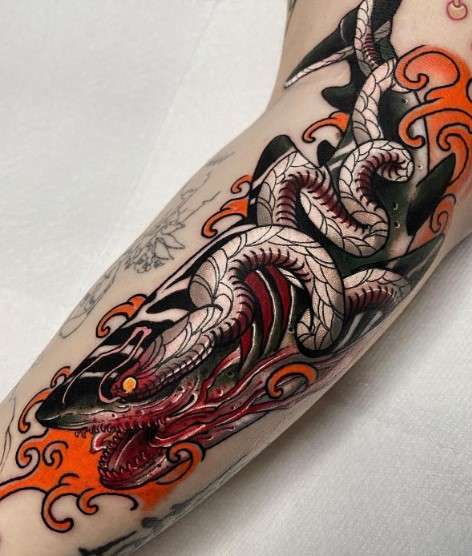
The symbolic meanings associated with Orochimaru tattoos:
- Orochimaru tattoos are highly symbolic and hold deep meaning for those who choose to adorn their bodies with this serpent deity.
- The main themes associated with orochimaru tattoos include power, wisdom, transformation, and rebirth.
- The snake, representing orochimaru, symbolizes both the destructive force and the regenerative power of nature.
- Individuals who choose orochimaru tattoos may seek to tap into their own inner strength, embrace change, and embark on a journey of personal growth and transformation.
- These tattoos often serve as a reminder of the cycle of life, death, and rebirth, as well as a symbol of resilience and adaptability.
Remember, orochimaru and his symbolic meanings delve into a world of mysticism and power. Whether you choose to explore this theme through folklore, literature, or body art, orochimaru remains an intriguing figure that captures the imagination and represents the eternal struggle for immortality and personal growth.
So, if you are searching for a tattoo that embodies the complexities of life and the potential for transformation, orochimaru might just be the perfect choice.
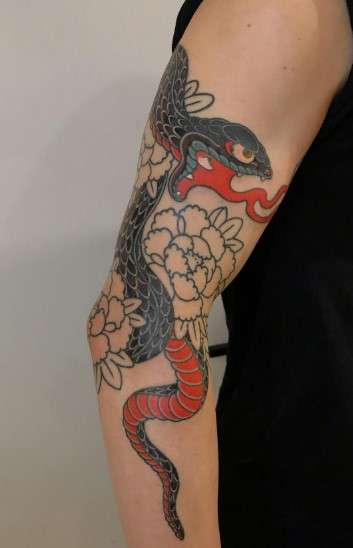
Yamata No Orochi: The Colossal Eight-Headed Serpent
Japanese snake tattoos have a rich history and deep symbolism, and one of the most intriguing snake creatures in japanese mythology is yamata no orochi. This colossal eight-headed serpent holds a significant place in japanese folklore and has become a popular subject for tattoo art.
Let’s delve into the mythical origins and significance of yamata no orochi and explore how it is interpreted in tattoos, showcasing the representation of power and transformation.
Mythical Origins And Significance Of Yamata No Orochi
- In japanese mythology, yamata no orochi is believed to be an ancient and powerful serpent born from the blood of izanami, the goddess of creation and death.
- This legendary creature is often depicted as a massive serpent with eight heads and eight tails, each representing a different characteristic or power.
- According to the myth, yamata no orochi terrorized the land, causing chaos and destruction. It demanded a sacrifice of a young maiden from the village of izumo every year.
- The shinto god, susanoo, took it upon himself to defeat yamata no orochi and save the village. With the help of a clever plan, susanoo managed to intoxicate the serpent with sake and slay it while it was incapacitated.
- The defeat of yamata no orochi symbolizes the triumph of good over evil and the restoration of harmony and balance in the world.

Interpreting The Symbolism Of Yamata No Orochi In Tattoo Art
- Yamata no orochi tattoos often embody various symbolic meanings. Some key interpretations include:
- Power and strength: The immense size and multiple heads of yamata no orochi represent unparalleled power and primal strength.
- Transformation and regeneration: The serpent shedding its skin symbolizes transformation, growth, and the cyclical nature of life.
- Protection and guardianship: Yamata no orochi tattoos may serve as a talisman, offering protection against negative energies and evil spirits.
- Wisdom and knowledge: Each head of yamata no orochi represents a different attribute, symbolizing wisdom, intelligence, and the acquisition of knowledge.
- Tattoo enthusiasts often choose yamata no orochi as a design to invoke these powerful characteristics and embrace the transformative journey of life.
- Artists incorporate intricate details and vibrant colors to capture the mystique and majesty of this legendary creature in tattoo art.
- The placement of yamata no orochi tattoos varies, with options including the back, chest, or full sleeve, allowing for a larger canvas to showcase the intricate design.
The allure of yamata no orochi tattoos lies in their representation of power, transformation, and connection to japanese mythology. These striking designs embody the spirit of the colossal serpent, capturing attention and symbolizing personal growth, protection, and wisdom. Whether you seek to evoke strength, embrace change, or honor the rich tapestry of japanese culture, a yamata no orochi tattoo can serve as a captivating and meaningful tribute.

The Spiritual Implications Of Snakes In Japanese Beliefs
Snakes hold significant spiritual implications in japanese beliefs, representing various aspects of guidance, protection, and symbolism in both shintoism and buddhism. Let’s delve into the mystical world of japanese snake tattoos and explore their spiritual significance.
Snakes As Spiritual Guides And Protectors
- In japanese culture, snakes are often seen as spiritual guides, offering wisdom and guidance to those who seek it.
- They are revered as protectors against evil spirits and bringers of good fortune, as they symbolize transformation, renewal, and rebirth.
- Snake tattoos are believed to grant the wearer the ability to navigate challenges and embrace change in life, ultimately leading to personal growth and enlightenment.
The Connection Between Snakes And Shintoism And Buddhism
- Snakes hold a prominent place in both shintoism and buddhism, two major religions in japan.
- In shintoism, snakes are revered as divine creatures that connect humans with the spirit world. They are believed to possess magical powers and have the ability to ward off evil.
- In buddhism, the snake represents spiritual awakening and shedding one’s old self to attain enlightenment. It is associated with the legendary naga, a semi-divine serpent-like entity known for its wisdom and protection.

Exploring Snake Motifs In Japanese Art And Architecture
- Snakes have been a popular motif in japanese art and architecture for centuries, with their presence depicted in various forms such as paintings, sculptures, and decorative patterns.
- Ouroboros, the symbol of a snake devouring its tail, represents the eternal cycle of life and death, symbolizing infinite transformation and continuity.
- Snake sculptures often guard temples, shrines, and sacred spaces, acting as protectors against negative forces and providing spiritual energy to the surroundings.
Japanese snake tattoos not only boast intricate designs and aesthetics but also carry deep spiritual meanings. They serve as reminders of the transformational power of change, the wisdom of guidance, and the protection granted by these mystical creatures. Whether you appreciate the symbolism behind them or simply admire their beauty, japanese snake tattoos are a captivating representation of spirituality in japanese culture.
The Association Of Snakes With Wisdom And Knowledge
In japanese culture is both fascinating and profound. From ancient literature to traditional art forms, snakes have been portrayed as symbols of enlightenment and intellectual prowess. In this section, we will explore the deep-rooted meaning behind snake tattoos in japanese culture, focusing on their representation of wisdom and enlightenment.
Let’s dive into the world of japanese snake tattoo meaning!

The Snake As A Representation Of Wisdom And Enlightenment:
- Snakes are revered for their ability to shed their skin, symbolizing renewal and transformation, which parallels the pursuit of knowledge and wisdom.
- The coiled nature of snakes is often associated with introspection and a deep understanding of oneself, highlighting their connection to inner wisdom.
- In japanese folklore, the mythical creature called the orochimaru represents a serpent with extraordinary knowledge and powers, further strengthening the association of snakes with wisdom.
- Snakes are believed to possess a keen sense of perception and observation, representing their ability to gain wisdom from their surroundings and experiences.
- The snake’s sinuous movements and graceful demeanor are seen as a metaphor for the fluidity of thought and the ability to adapt to different situations, synonymous with intellectual prowess and enlightenment.
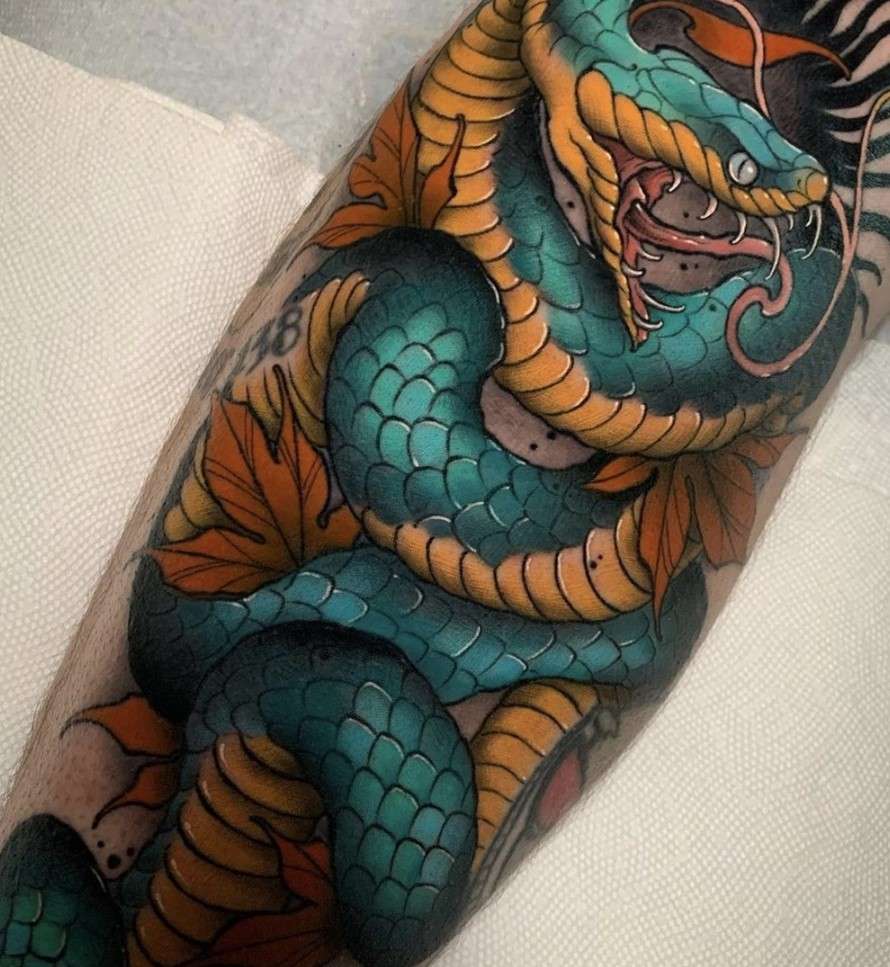
Snake Symbolism In Traditional Japanese Literature And Poetry:
- Many classic works of japanese literature, such as the “tale of the genji,” feature snake symbolism to convey philosophical and spiritual themes, including the pursuit of wisdom.
- Snake imagery is often used to depict characters who possess great wisdom and insight, showcasing the deep respect japanese culture holds for those who seek knowledge.
- In poetry, snakes are frequently mentioned as a symbol of enlightenment and the transcendence of worldly desires, emphasizing the importance of spiritual growth and intellectual development.
Tattoo Designs Showcasing Snakes As Bearers Of Wisdom:
- Snake tattoos are popular among those seeking to embody the attributes of wisdom and enlightenment, as they serve as a constant reminder of the pursuit of knowledge.
- Traditional japanese snake tattoo designs often incorporate elements such as scales, fangs, and sinuous patterns to symbolize wisdom, strength, and transformation.
- The placement of snake tattoos can vary, but they are commonly seen coiled around the arm or leg, emphasizing the connection between the snake’s wisdom and the individual’s journey towards enlightenment.
- Some tattoo designs may include other symbolic elements, such as cherry blossoms representing the transient nature of life or waves symbolizing the ebb and flow of knowledge.
Snake tattoos in japanese culture hold a profound significance as symbols of wisdom, enlightenment, and personal growth. The association of snakes with intellectual prowess and the pursuit of knowledge resonates deeply within japanese folklore, literature, and art. Whether as a reminder of one’s own journey or an embodiment of the desire for wisdom, a snake tattoo can be a powerful symbol of personal transformation and enlightenment.
Traditional Japanese Snake Tattoo Styles And Techniques
Irezumi: The Traditional Art Of Japanese Tattooing
In the world of tattoo art, japanese culture holds a special place with its unique and symbolic designs. One prominent element of japanese tattooing is the snake, which has its own deep meaning rooted in japanese folklore and mythology. Traditional japanese snake tattoos, known as irezumi, are not only visually striking but also carry significant symbolism.
So, let’s delve into the traditional japanese snake tattoo styles and techniques to understand the allure of this ancient art form.
The use of bold lines and vibrant colors in snake tattoos:
- Japanese snake tattoos are characterized by bold, thick lines that give the design a powerful and impactful appearance. These strong lines are meticulously etched into the skin, creating a visually striking effect.
- Vibrant colors play a crucial role in traditional japanese snake tattoos. Reds, yellows, and greens are commonly used to bring the snake to life. These colors symbolize different aspects of the snake’s character, such as passion, courage, and longevity.
Incorporating traditional japanese motifs into snake designs:
- Traditional japanese snake tattoos often incorporate various motifs from japanese culture. For example, cherry blossoms, waves, koi fish, and dragons are frequently seen alongside snakes, adding depth and symbolism to the design.
- Each motif holds its own meaning, contributing to the overall narrative of the tattoo. Cherry blossoms symbolize the transient nature of life, while waves represent the power and unpredictability of nature. By intertwining these elements with the snake, a unique story unfolds on the wearer’s skin.
So, whether you’re fascinated by the artistry of irezumi or intrigued by the rich symbolism behind traditional japanese snake tattoos, there’s no denying the mesmerizing beauty of this ancient art form. The intricate techniques, vibrant colors, and incorporation of traditional motifs create tattoos that not only capture the eye but also celebrate the profound cultural heritage of japan.
Modern Interpretations: Fusion Of Traditional And Contemporary Elements
The world of tattooing has seen a constant evolution, with traditional designs blending seamlessly with modern elements to create captivating and meaningful artwork. Japanese snake tattoos, in particular, showcase this fusion of old and new, as they bring together traditional symbolism and contemporary design techniques.
In this blog post, we will explore the modern interpretations of japanese snake tattoos, exploring three distinct styles: neo-traditional, minimalist, and geometric. Each style adds its own unique twist to the ancient symbolism of the snake, resulting in visually stunning and deeply symbolic tattoos.
Let’s dive in and explore these captivating designs!
Neo-Traditional Snake Tattoos: Combining The Old And New
- These tattoos merge the bold, vibrant colors and meticulous linework of traditional japanese art with a modern approach to design.
- They often feature a snake as the central figure, with intricate detailing and vivid hues to bring it to life.
- Neo-traditional snake tattoos retain the traditional elements of japanese snake symbolism, such as wisdom, protection, and transformation, while incorporating contemporary aesthetics.
Minimalist Snake Tattoo Designs: Simplicity With A Powerful Meaning
- Minimalist snake tattoos strip down the intricate details, focusing on simplicity and clean lines.
- These designs often adopt a more abstract style, using minimalist shapes and patterns to convey the essence of the snake.
- Despite their simplicity, minimalist snake tattoos carry a profound meaning, representing rebirth, wisdom, and healing in a subtle yet impactful way.
Geometric Snake Tattoos: Adding A Modern Twist To Ancient Symbolism
- Geometric snake tattoos combine the precision of geometric shapes with the mystical allure of the snake.
- These designs feature symmetrical patterns, intricate linework, and sharp angles, resulting in visually captivating and contemporary tattoos.
- Geometric snake tattoos symbolize the duality of nature, representing both chaos and order, as well as transformation and regeneration within a structured framework.
Whether you prefer the traditional-meets-modern charm of neo-traditional snake tattoos, the understated power of minimalist designs, or the captivating allure of geometric snake tattoos, japanese snake tattoos offer a plethora of options for expressing your personality and embracing the ancient symbolism of the serpent.
These modern interpretations ensure that the timeless meanings associated with snakes remain relevant to contemporary tattoo enthusiasts, making these designs both visually stunning and deeply symbolic.
Self-Discovery And Personal Transformation Through Snake Tattoos
Snake tattoos have become increasingly popular in recent years, not only for their bold and striking designs but also for the powerful symbolism they hold. Many individuals choose to adorn their bodies with these serpent motifs as a means of expressing their own unique journeys of self-discovery and personal transformation.
Here, we explore how snake tattoos serve as a powerful representation of overcoming obstacles, embracing change, reflecting personal growth, and embodying resilience.
Expressing Individualistic Journeys Through Snake Motifs
- Snake tattoos are a deeply personal form of expression, allowing individuals to showcase their individualistic journeys and experiences.
- The intricate designs and coiling nature of snake tattoos symbolize the winding path of life and the diverse challenges one may encounter along the way.
- The choice of colors, patterns, and styles used in snake tattoos can further personalize the representation, allowing for a more intimate and meaningful portrayal of one’s unique journey.
Overcoming Obstacles And Embracing Change With Snake Tattoos
- Snakes are often associated with transformation and rebirth, making them a potent symbol for overcoming obstacles and embracing change in one’s life.
- The shedding of the snake’s skin represents the shedding of old beliefs, habits, and limitations, allowing for personal growth and self-improvement.
- Snake tattoos can serve as a constant reminder of the importance of adaptability and embracing change, encouraging individuals to face challenges head-on and come out stronger on the other side.
Reflecting Personal Growth And Resilience With Serpent Ink
- Snake tattoos can visually capture the strength and resilience that individuals possess, showcasing their ability to withstand life’s trials and adversities.
- The coiled nature of snake tattoos can represent inner strength and determination, reminding individuals of their capacity to rise above difficult circumstances.
- Snake tattoos can act as a symbol of personal growth, reminding the wearer of how far they have come on their journey and inspiring them to continue pushing forward.
Incorporating a snake tattoo into one’s body art not only allows for self-expression but also acts as a constant reminder of the transformative power within us all. Through its symbolism of self-discovery, overcoming obstacles, and personal growth, a snake tattoo can serve as a visual representation of a journey that is unique to each individual.
Frequently Asked Questions On Japanese Snake Tattoo Meaning
What Is The Meaning Of A Japanese Snake Tattoo?
A japanese snake tattoo symbolizes wisdom, strength, protection, transformation, and the cycle of life.
Are There Different Types Of Japanese Snake Tattoos?
Yes, there are various types of japanese snake tattoos, such as the nue, hebi, and orochi, each with its unique symbolism.
How Should I Choose The Right Japanese Snake Tattoo Design?
Consider elements like color, style, size, and placement to select a japanese snake tattoo design that personally resonates with you.
Conclusion
With its rich cultural history and symbolism, the japanese snake tattoo holds deep meaning for those who choose to adorn their bodies with this intricate design. The serpent, often portrayed with a fierce and majestic demeanor, is a powerful symbol of transformation, wisdom, and protection in japanese culture.
The snake’s ability to shed its skin represents personal growth and the shedding of one’s past, while its association with water signifies fluidity and adaptability. Moreover, the snake is also seen as a protective guardian, warding off evil spirits and bringing good fortune.
Whether adorned as a full sleeve or a small, discreet design, the japanese snake tattoo is a captivating choice for those seeking a blend of beauty and profound significance. As you choose to embark on this symbolic journey, may the japanese snake tattoo empower you to embrace your own transformation and embrace the wisdom it represents.
